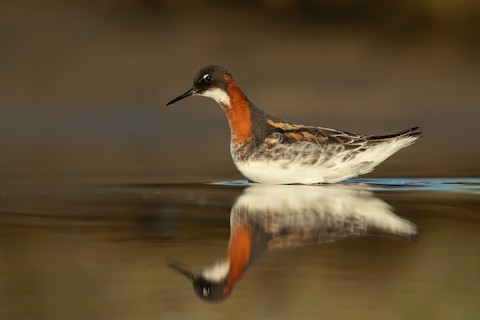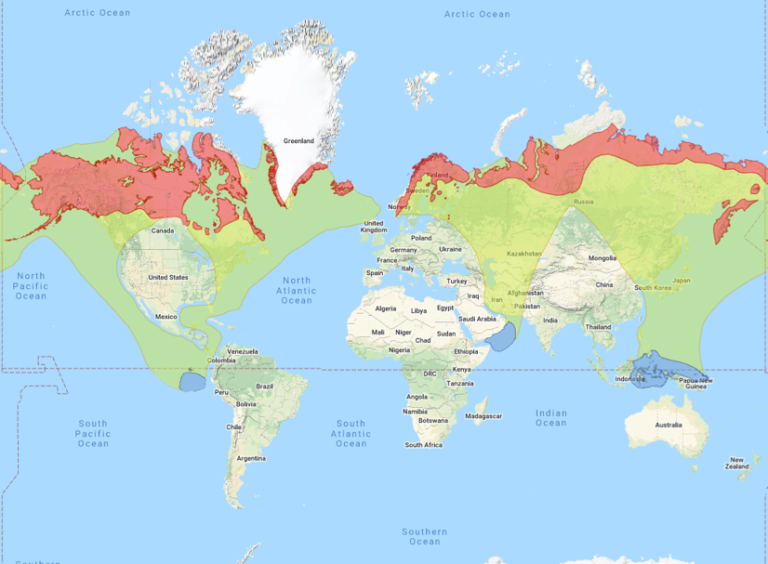Birdfinding.info ⇒ One of the most global bird species, with a circumpolar breeding range and expansive oceanic winter range, and migrating across much of North America, Eurasia, and the northern oceans. Abundant on its remote nesting grounds, especially on coastal tundra plains. In North America, it is common during migration (late April into June, and late July through September) along the Pacific coast and offshore from both coasts—and is often seen on pelagic trips.
Red-necked Phalarope
Phalaropus lobatus
Breeds in arctic and subarctic wetlands. Winters in warm seas.
Breeding. Breeds in June and July in tundra, bogs, and marshes all around the arctic and subarctic, including Alaska, Canada, Greenland, Iceland, Scandinavia, and the full length of Russia.
Nesting areas include coastal plains of the Arctic Ocean and extend far inland and south. In the Russian Far East, nests south to Sakhalin, southern Kamchatka, and the Commander Islands; in Alaska, to the Aleutians and Alaska Peninsula; in Canada to northern Alberta, Saskatchewan, James Bay, and southern Labrador; and in Europe, locally to Ireland, Scotland, and central Finland.
Nonbreeding. Winters at sea mainly in three known areas: (1) the eastern Pacific offshore from Ecuador and Peru, including the Galápagos; (2) the Arabian Sea; and (3) the western Pacific in waters of Indonesia and Papua New Guinea.
Small numbers winter elsewhere: in the eastern Pacific north to California; Africa’s Great Lakes and along the coast of Kenya and Tanzania; along the coasts of southern India and Sri Lanka; the Gulf of Siam; along both sides of the Malay Peninsula; and all around the coasts of Australia.
In the South Atlantic, a few winter along the coast of Namibia and South Africa—but otherwise not known to occur at all the western Atlantic south of the Caribbean.
Movements. Northbound migration begins in late March and lasts into June but occurs mainly during April and May.
In the Americas, most migrants remain in Pacific offshore waters, or track along the coast, until they reach California, then head northeast across the western half of the continent and the northern Great Plains.
In western Eurasia, most migration is directly overland from the Arabian Sea to the arctic, with very small numbers passing through western Europe. In eastern Eurasia, most migration remains at sea north to Russia and the Bering Sea.
Southbound migration begins in late June with the departure of females almost immediately after laying their eggs. Males and juveniles depart the breeding grounds over the course of July and August. By early October, few migrants remain in temperate latitudes.
Most fall migrants return along essentially the same routes as in spring, except that juveniles disperse more widely in eastern North America and western Europe.
Small numbers of spring and fall migrants are detected in the West Indies—mostly in the Greater Antilles and Bahamas. Also regular in small numbers in the Mediterranean.
Vagrants can occur nearly anywhere in the world and have been recorded from, e.g.: Argentina, Madagascar, the Seychelles, Diego Garcia, New Zealand, Guam, and Hawaii.
Identification
The most widespread and “typical” phalarope—it can resemble both of the other phalaropes and overlaps with both of them nearly throughout their ranges.
Red-necked is the smallest and most evenly proportioned phalarope (both Red and Wilson’s are proportionately large-bodied). Its bill is thin, black and medium-length.
Like other phalaropes, Red-necked reverses the usual sex roles: females are larger and more colorful than males, and depart immediately after laying the eggs.
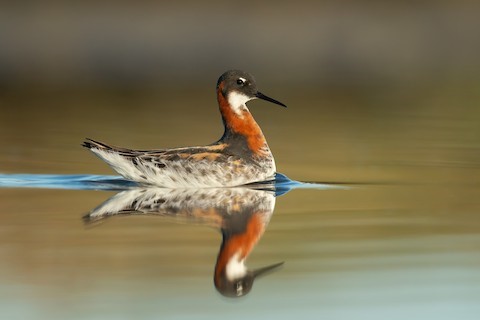
Red-necked Phalarope, female in breeding plumage. (Heron Bay, San Leandro, California; May 25, 2020.) © Dorian Anderson
Female in breeding plumage has mostly dark-gray upperparts, with a broad brick-red streak that curves down the sides of its neck from the back of the head, joining on the chest. The female also has a white throat, a white spot over the eye, and a buffy or orange streaks on the scapulars and wing coverts.
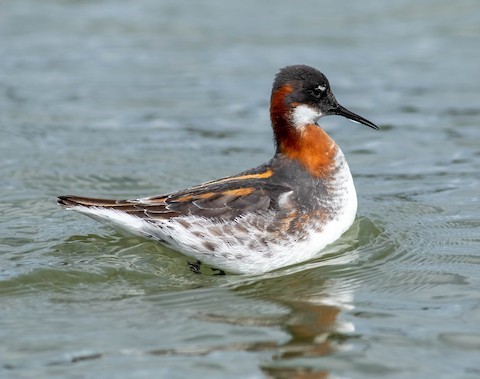
Red-necked Phalarope, female in breeding plumage. (West Head, Shelburne, Nova Scotia; May 10, 2020.) © Bill Crosby

Red-necked Phalarope, female in breeding plumage. (Gambell, St. Lawrence Island, Alaska; May 31, 2011.) © David Hollie
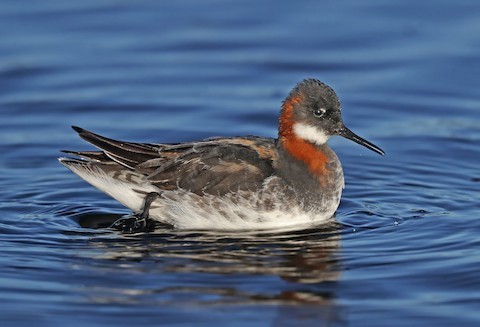
Red-necked Phalarope, female in breeding plumage. (Bodega Bay, California; April 21, 2019.) © Matt Davis
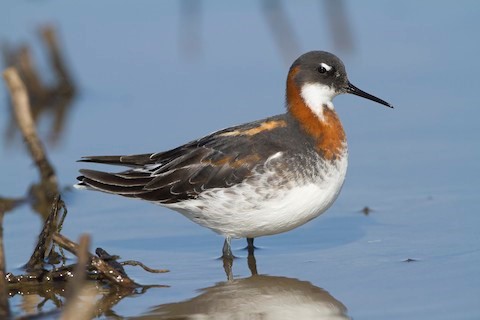
Red-necked Phalarope, female in breeding plumage. (Linton, Indiana; May 13, 2013.) © Michael Brown

Red-necked Phalarope, female in breeding plumage. (Montoursville, Lycoming County, Pennsylvania; May 11, 2015.) © David Brown
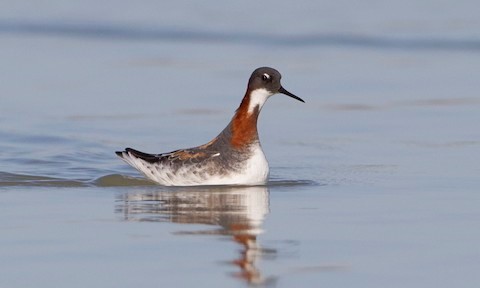
Red-necked Phalarope, female in breeding plumage. (Red Hill, California; April 28, 2014.) © Brian Sullivan
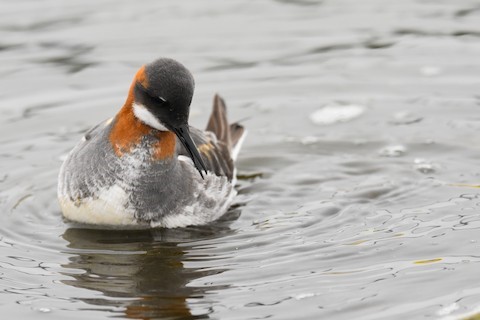
Red-necked Phalarope, female in breeding plumage. (Deadhorse, Alaska; June 6, 2020.) © Andy Bankert
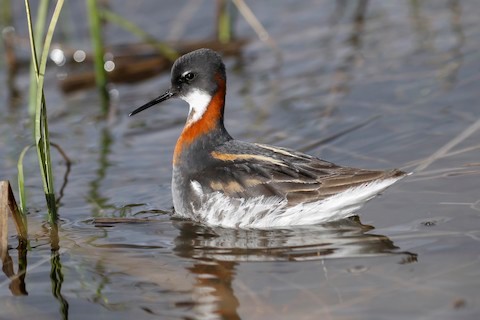
Red-necked Phalarope, female in breeding plumage. (Västra-Malmagen, Sweden; June 11, 2017.) © James Kennerley
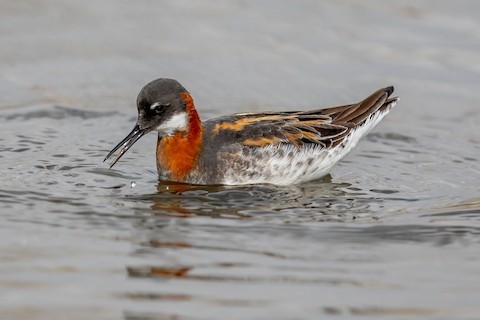
Red-necked Phalarope, female in breeding plumage. (Belmar Park, Lakewood, Colorado; May 2, 2019.) © Robert Raker
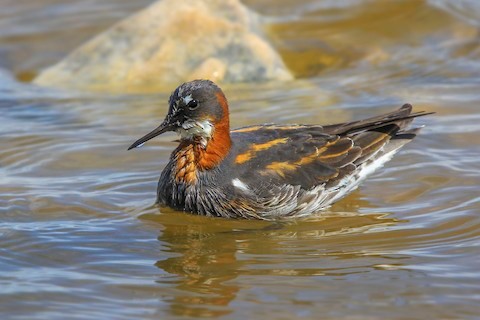
Red-necked Phalarope, female in breeding plumage. (Antelope Island State Park, Utah; May 19, 2016.) © Matthew Pendleton

Red-necked Phalarope, female in breeding plumage. (Komagnes, Finnmark, Norway; June 17, 2015.) © Ian Davies
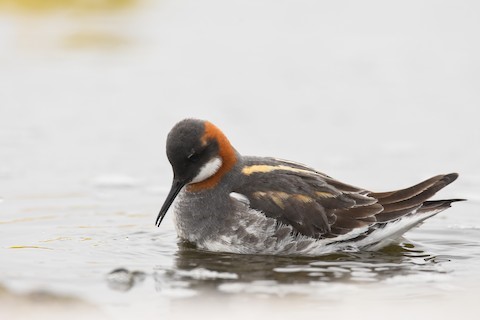
Red-necked Phalarope, female in breeding plumage. (Deadhorse, Alaska; June 6, 2020.) © Andy Bankert

Red-necked Phalarope, female in breeding plumage. (Prudhoe Bay, Alaska; June 23, 2015.) © Zak Pohlen
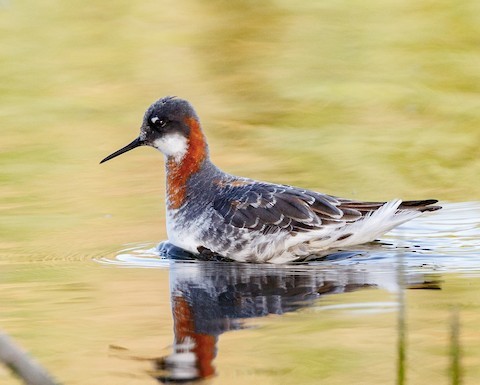
Red-necked Phalarope, female molting into breeding plumage. (Ballona Wetlands Ecological Reserve, Los Angeles, California; April 13, 2018.) © Chezy Yusuf
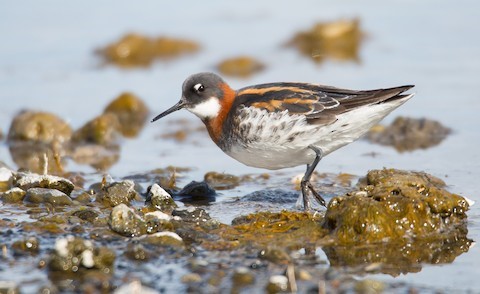
Red-necked Phalarope, female in breeding plumage. (Roberts, Idaho; May 13, 2014.) © Darren Clark
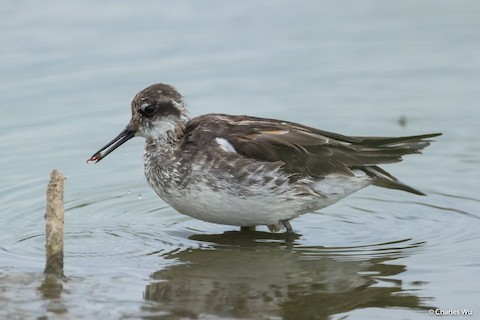
Red-necked Phalarope, female entering breeding plumage. (Nanhui Dongtan, Shanghai, China; May 5, 2018.) © Charles Wu
Male in breeding plumage looks like a washed-out, streaky version of the female, but with a slightly different pattern. Usually shows at least a subtle orange or reddish eyebrow that begins behind the eye then continues as a streak down the side of the neck.
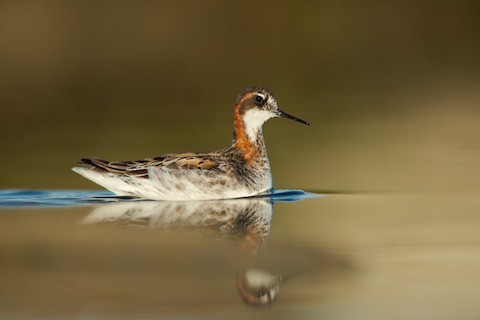
Red-necked Phalarope, male in breeding plumage, showing reddish eyebrow stripe. (Heron Bay, San Leandro, California; May 25, 2020.) © Dorian Anderson
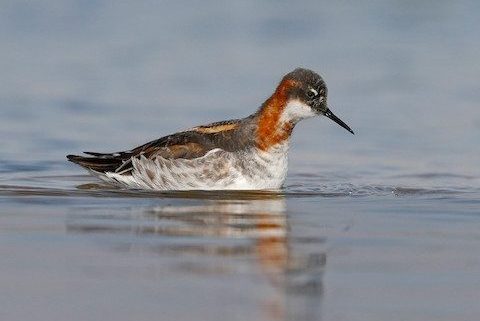
Red-necked Phalarope, male in breeding plumage. (Salhiya Intermittent Wetlands, Qazvin, Iran; May 6, 2017.) © Ali Sangchooli
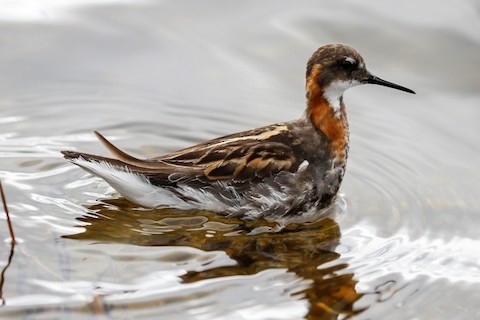
Red-necked Phalarope, male in breeding plumage. (Västra-Malmagen, Sweden; June 11, 2017.) © James Kennerley
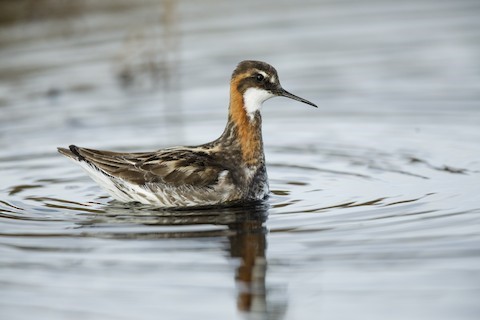
Red-necked Phalarope, male in breeding plumage. (Deadhorse, Alaska; June 24, 2018.) © Nick Athanas
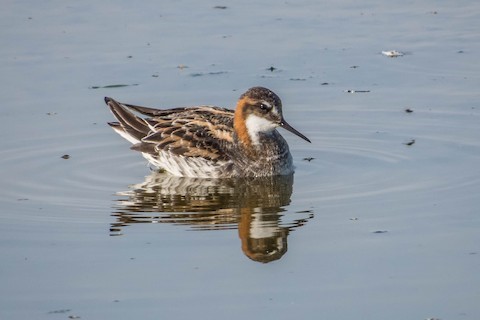
Red-necked Phalarope, male in breeding plumage. (Ottawa, Ontario; June 8, 2014.) © Darryl Ryan
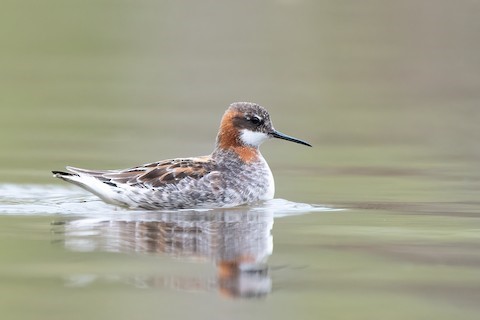
Red-necked Phalarope, male in breeding plumage. (Little Met Wetlands, Rocky River Reservation, Cleveland, Ohio; May 10, 2018.) © Kevin Pero
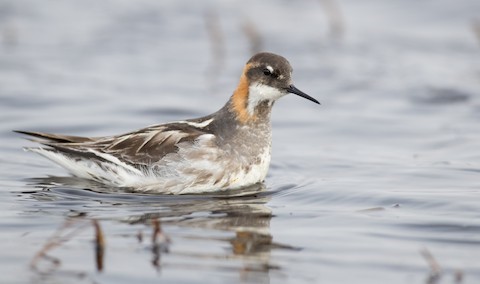
Red-necked Phalarope, male in breeding plumage. (Goose Bay, Alaska; May 23, 2019.) © Justin Saunders
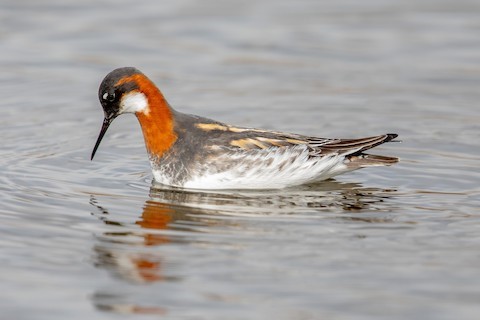
Red-necked Phalarope, male in peak breeding plumage, showing reddish eyebrow stripe. (Belmar Park, Lakewood, Colorado; May 2, 2019.) © Robert Raker
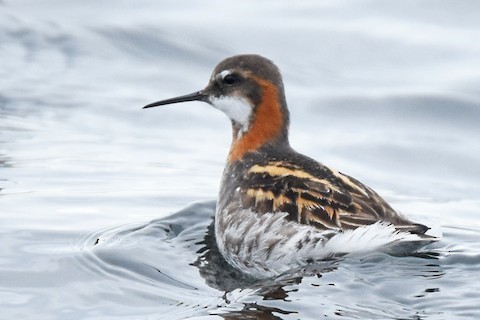
Red-necked Phalarope, male in breeding plumage. (Offshore from Saguenay, Quebec; June 9, 2019.) © Marie O’Neill
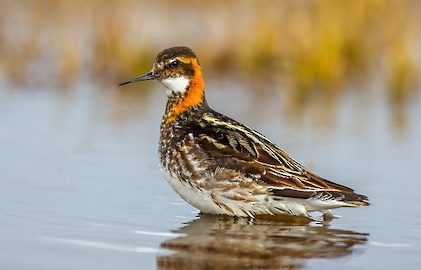
Red-necked Phalarope, male in breeding plumage. (Cake Eater Road, Barrow, Alaska; June 15, 2017.) © Eric Gofreed
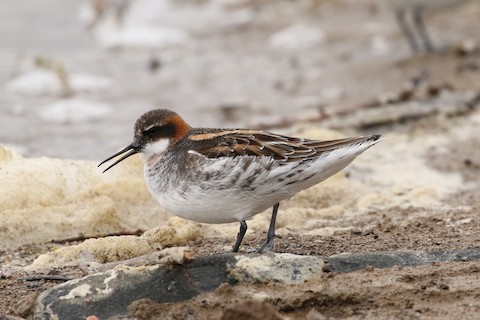
Red-necked Phalarope, male in breeding plumage. (Lakewood, Colorado; May 19, 2017.) © Mark Chavez
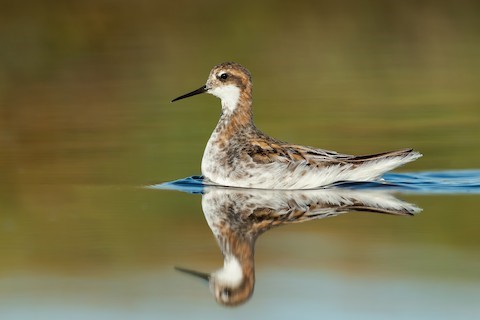
Red-necked Phalarope, male in breeding plumage. (Heron Bay, San Leandro, California; May 25, 2020.) © Dorian Anderson
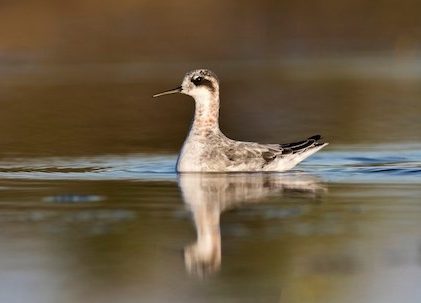
Red-necked Phalarope, male molting into breeding plumage. (Lac Antsirabe, Toliara, Madagascar; April 30, 2015.) © Zak Pohlen
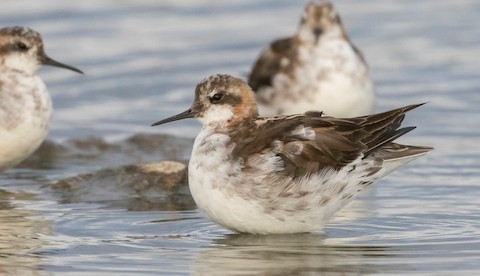
Red-necked Phalarope, male molting out of breeding plumage. (Bakkatjörn, Höfuðborgarsvæði, Iceland; August 5, 2019.) © Caleb Putnam
Adults in nonbreeding plumage are mostly gray above and have a distinctive (but shared by nonbreeding Red Phalarope) blackish mask-stripe that extends from around the eye back to the ear-coverts. At a distance, their most distinctive features are a divided rump (dark in the middle, white on the sides) and prominent white wing-stripe.
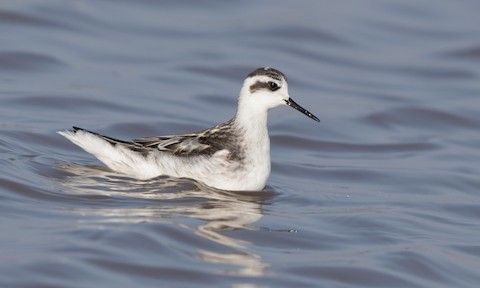
Red-necked Phalarope, molting into nonbreeding plumage. (Moss Landing Wildlife Area, California; August 16, 2018.) © Steve Kelling
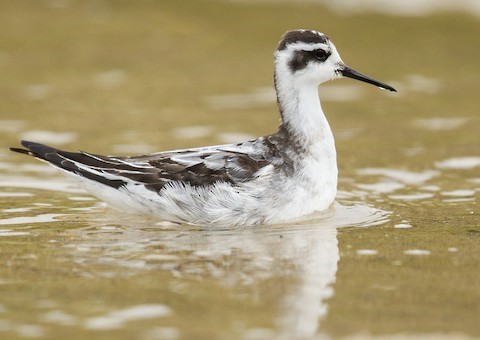
Red-necked Phalarope, molting into nonbreeding plumage. (Half Moon Bay, California; August 23, 2013.) © Caroline Lambert
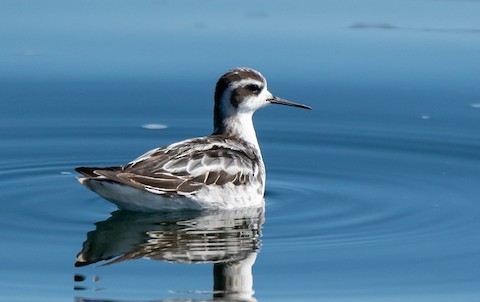
Red-necked Phalarope, nonbreeding plumage. (Lake Pleasant, Maricopa County, Arizona; November 5, 2019.) © Mary McSparen

Red-necked Phalarope, nonbreeding plumage. (Lake Pleasant, Maricopa County, Arizona; November 5, 2019.) © Mary McSparen
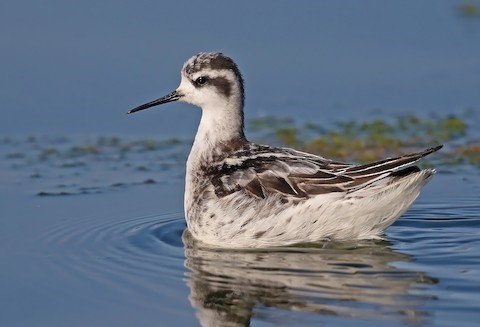
Red-necked Phalarope, nonbreeding plumage. (Moss Landing, California; September 10, 2015.) © Matt Davis

Red-necked Phalarope, nonbreeding plumage. (Watson Lake, Prescott, Arizona; October 13, 2017.) © Eric Gofreed
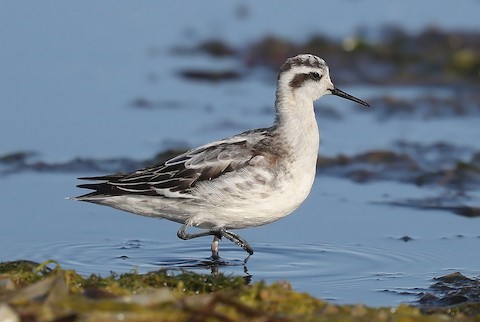
Red-necked Phalarope, nonbreeding plumage. (Bodega Bay, California; September 1, 2018.) © Matt Davis
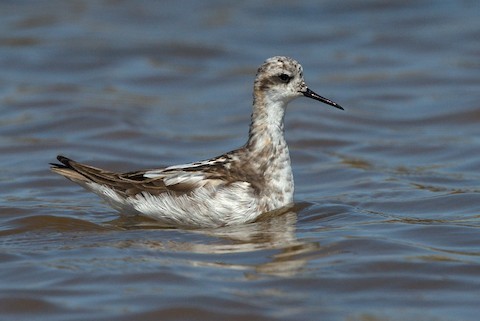
Red-necked Phalarope, male molting into nonbreeding plumage. (Toms Point, Tomales Bay, Marin County, California; August 12, 2019.) © David Lumpkin

Red-necked Phalarope, nonbreeding plumage. (Prineville Sewage Ponds, Prineville, Oregon; August 25, 2017.) © Charles Gates
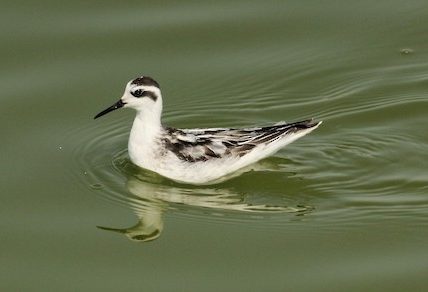
Red-necked Phalarope, nonbreeding plumage. (Prineville Sewage Ponds, Prineville, Oregon; August 25, 2017.) © Charles Gates
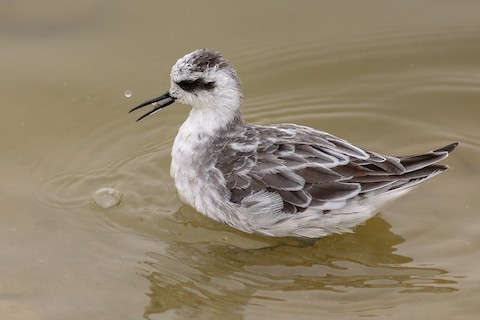
Red-necked Phalarope, nonbreeding plumage. (Al Reem, Dubai, United Arab Emirates; March 23, 2019.) © Laurent Esselen
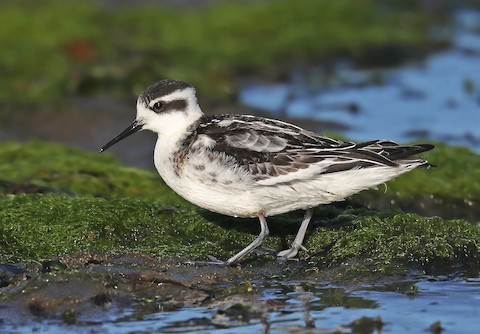
Red-necked Phalarope, nonbreeding plumage. (Bodega Bay, California; September 8, 2019.) © Matt Davis
Immatures generally resemble nonbreeding adults, but go through a briefly-held juvenile plumage in which the upperparts have buffy feather edges.
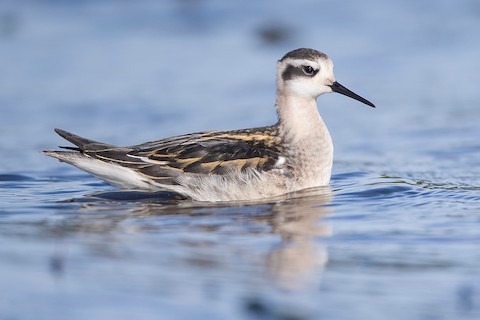
Red-necked Phalarope, juvenile. (Eagle Lake, British Columbia; August 29, 2020.) © Jeff Dyck
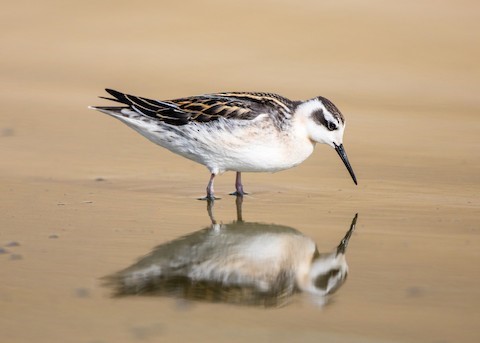
Red-necked Phalarope, juvenile. (Ballona Creek, Los Angeles, California; August 25, 2018.) © Rhys Marsh
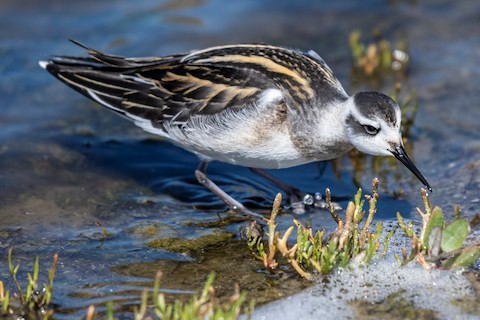
Red-necked Phalarope, juvenile. (Pistol River State Park, Oregon; July 23, 2020.) © Gerry Meenaghan
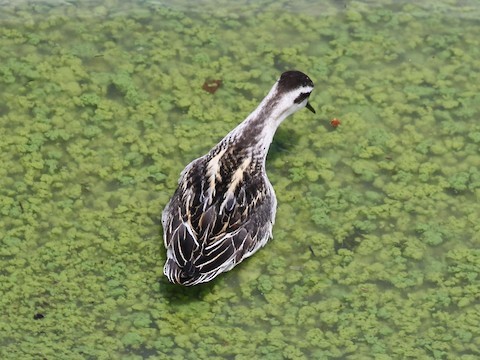
Red-necked Phalarope, juvenile. (Maumee Bay State Park, Lucas County, Ohio; September 3, 2017.) © Paul Jacyk
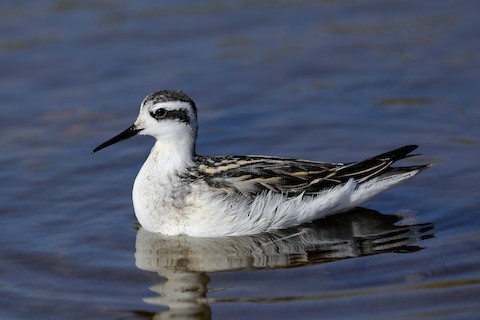
Red-necked Phalarope, juvenile. (Pier 94, San Francisco, California; August 27, 2020.) © Aaron Maizlish
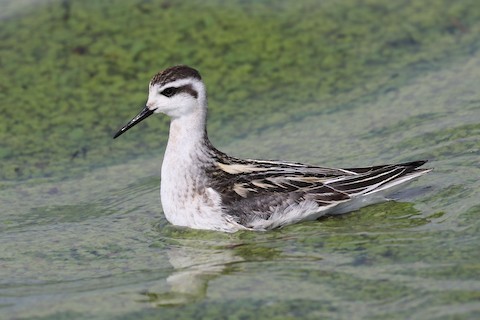
Red-necked Phalarope, juvenile. (Maumee Bay State Park, Lucas County, Ohio; September 3, 2017.) © Paul Jacyk

Red-necked Phalarope, juvenile. (Wakarusa Wastewater Treatment Facility, Elkhart, Indiana; October 1, 2018.) © Thaddaeus Shaum

Red-necked Phalarope, juvenile. (Rondeau Provincial Park, Ontario; August 31, 2012.) © J B
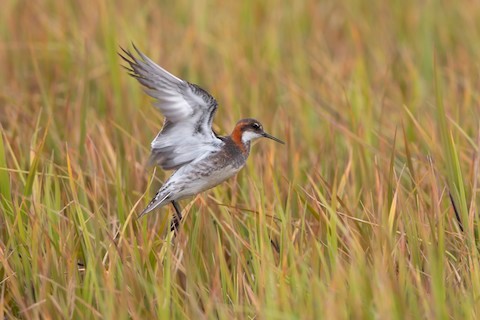
Red-necked Phalarope, male in breeding plumage. (Sheep Lake, St. Paul Island, Alaska; June 7, 2019.) © Marco Valentini
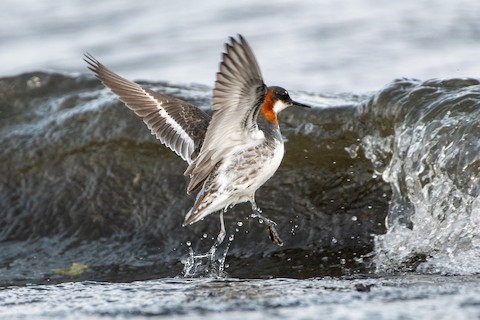
Red-necked Phalarope, female in breeding plumage. (Lake Elmore, Vermont; June 10, 2020.) © Richard Littauer
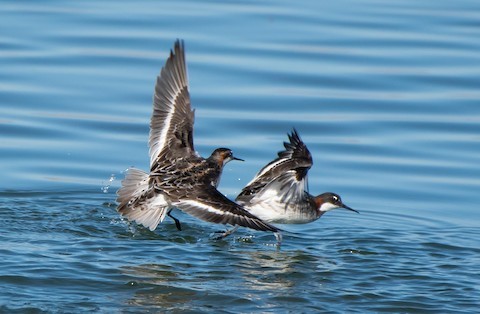
Red-necked Phalarope, male chasing female. (Glendale Recharge Ponds, Arizona; May 20, 2020.) © Mary McSparen
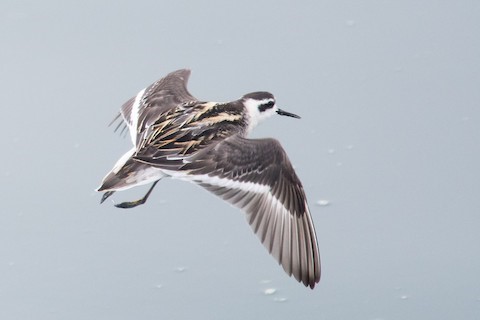
Red-necked Phalarope, juvenile, showing divided rump and white wing-stripe. (Offshore from San Diego, California; August 7, 2019.) © Nancy Christensen

Red-necked Phalarope, juvenile, showing divided rump and white wing-stripe. (Pedder Bay, British Columbia; September 3, 2018.) © Blair Dudeck
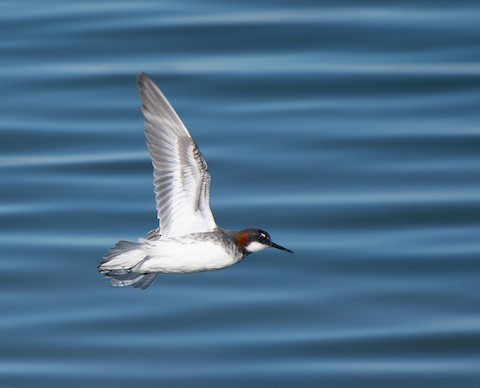
Red-necked Phalarope, female in breeding plumage. (Glendale Recharge Ponds, Arizona; May 20, 2020.) © Mary McSparen

Red-necked Phalarope, showing white wing-stripe. (Watson Lake, Prescott, Arizona; October 13, 2017.) © Eric Gofreed
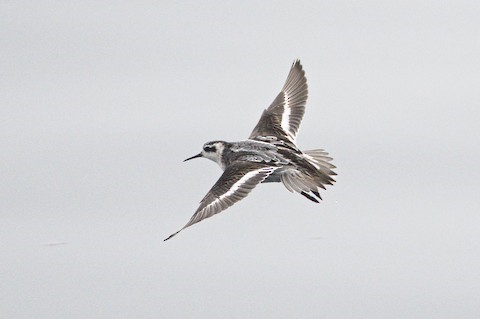
Red-necked Phalarope, nonbreeding plumage, showing divided rump and white wing-stripe. (Offshore from Half Moon Bay, California; September 13, 2020.) © Nico Stuurman
Cf. Wilson’s Phalarope. Red-necked and Wilson’s Phalaropes occur together during migration and are similar enough to be confusing under some circumstances—especially the breeding male plumages, in which both species have a somewhat blurred blend of rust, gray, and white on their necks.
The key differences, which hold true in all plumages, are size, bill length, wing pattern, and rump pattern. Wilson’s is substantially larger and proportionately longer-billed, and has a plain, unmarked wing, and an all-white rump, whereas Red-necked has a whitish wing-stripe and divided rump: blackish in the middle and white on the sides.
In nonbreeding plumages, Red-necked and Wilson’s also differ in head pattern. Red-necked has a blackish mask that extends to the ear-coverts, whereas Wilson’s has a faint, pale-grayish mask that extends down the neck.
Cf. Red Phalarope. Red-necked and Red Phalaropes are the only two pelagic sandpipers, and often flock together at sea. Their normal ranges overlap widely and because both are world travelers they can occur anywhere. The nonbreeding plumages are readily confused, especially under suboptimal maritime viewing conditions.
Both species are also somewhat variable in their nonbreeding plumages, so it is difficult to make reliable generalizations, but in most cases the general coloration of the upperparts is strong indicator: Red tends to have extensively pale-gray upperparts, where Red-necked tends to be medium-gray—and usually also has darker streaks. However, some Red-necks have unmarked uniform-gray upperparts, and some first-year Reds retain darker, partly streaked remnants of the juvenile plumage.
Red-necked tends to show more contrast on the rump: blackish in the center and white or whitish on the sides. Red’s rump varies and can also show a dark center and white or whitish sides, but the contrast is less pronounced, so it appears more evenly grayish (and sometimes very pale, whitish overall—totally unlike Red-necked). The tails also differ somewhat, as Red tends to appear broad and Red-necked narrow.
If seen clearly at close range, the bill shapes can also be diagnostic. Red-necked has a thinner, medium-length bill that is always black, whereas Red has a comparatively short, broad bill that is yellow in the breeding season and at other times can appear all-black but often shows some paler coloration, especially around the base.
Their voices also differ. Red-necked’s typical calls are sharp, medium-pitched chip notes whereas Red’s are either high-pitched, metallic chip notes or more textured, throaty seep notes.

Red (at left) and Red-necked Phalaropes in nonbreeding plumage, showing subtle differences in back, rump, and tail patterns. (Nantucket, Massachusetts; September 22, 2019.) © Benjamin Hack
Notes
Monotypic species.
References
Alderfer, J., and J.L. Dunn. 2014. National Geographic Complete Birds of North America (Second Edition). National Geographic Society, Washington, D.C.
Ascanio, D., G.A. Rodriguez, and R. Restall. 2017. Birds of Venezuela. Christopher Helm, London.
BirdLife International. 2019. Phalaropus lobatus (amended version of 2018 assessment). The IUCN Red List of Threatened Species 2019: e.T22693490A155525960. https://dx.doi.org/10.2305/IUCN.UK.2018-2.RLTS.T22693490A155525960.en. (Accessed November 9, 2020.)
Brazil, M. 2009. Birds of East Asia. Princeton University Press.
de la Peña, M.R., and M. Rumboll. 1998. Birds of Southern South America and Antarctica. Princeton University Press.
eBird. 2020. eBird: An online database of bird distribution and abundance. Cornell Lab of Ornithology, Ithaca, N.Y. http://www.ebird.org. (Accessed November 9, 2020.)
ffrench, R. 2012. A Guide to the Birds of Trinidad & Tobago (Third Edition). Cornell University Press.
Garcia-del-Rey, E. 2011. Field Guide to the Birds of Macaronesia: Azores, Madeira, Canary Islands, Cape Verde. Lynx Editions, Barcelona.
Hollom, P.A.D., R.F. Porter, S. Christensen, and I. Willis. 1988. Birds of the Middle East and North Africa. T & AD Poyser, Calton, England.
Howell, S.N.G., and S. Webb. 1995. A Guide to the Birds of Mexico and Northern Central America. Oxford University Press.
Howell, S.N.G., and K. Zufelt. 2019. Oceanic Birds of the World. Princeton University Press.
Jaramillo, A. 2003. Birds of Chile. Princeton University Press.
Johnson, S.R., and D.R. Herter. 1989. The Birds of the Beaufort Sea. BP Exploration (Alaska) Inc., Anchorage, Alaska.
Kirwan, G.M., A. Levesque, M. Oberle, and C.J. Sharpe. 2019. Birds of the West Indies. Lynx Edicions, Barcelona.
Marchant, J., T. Prater, and P. Hayman. 1986. Shorebirds: An Identification Guide to the Waders of the World. Houghton Mifflin, Boston.
McMullan, M., and T. Donegan. 2014, Field Guide to the Birds of Colombia (Second Edition). Fundación Proaves de Colombia, Bogotá.
Mullarney, K., L. Svensson, D. Zetterström, and P.J. Grant. 1999. Birds of Europe. Princeton University Press.
Pyle, R.L., and P. Pyle. 2017. The Birds of the Hawaiian Islands: Occurrence, History, Distribution, and Status. Version 2 (January 1, 2017). http://hbs.bishopmuseum.org/birds/rlp-monograph/. B.P. Bishop Museum, Honolulu, Hawaii.
Raffaele, H., J. Wiley, O. Garrido, A. Keith, and J. Raffaele. 1998. A Guide to the Birds of the West Indies. Princeton University Press.
Ridgely, R.S., and P.J. Greenfield. 2001. The Birds of Ecuador, Volume II: Field Guide. Cornell University Press.
Ridgely, R.S., and J.A. Gwynne. 1989. A Guide to the Birds of Panama (Second Edition). Princeton University Press.
Robson, C. 2002. Birds of Thailand. Princeton University Press.
Salt, W.R., and J.R. Salt. 1976. The Birds of Alberta. Hurtig Publishers, Edmonton, Alberta.
Schulenberg, T.S., D.F. Stotz, D.F. Lane, J.P. O’Neill, and T.A. Parker. 2007. Birds of Peru. Princeton University Press.
Sibley, D.A. 2000. The Sibley Guide to Birds. Alfred A. Knopf. New York.
Sinclair, I., P. Hockey, W. Tarboton, and P. Ryan. 2011. Birds of Southern Africa (Fourth Edition). Random House Struik (Pty) Ltd. Cape Town, South Africa.
Wells, J.V., and A.C. Wells. 2017. Birds of Aruba, Bonaire, and Curaçao. Cornell University Press.
Xeno-Canto. 2020. Red-necked Phalarope – Phalaropus lobatus. https://www.xeno-canto.org/species/Phalaropus-lobatus. (Accessed November 9, 2020.)
